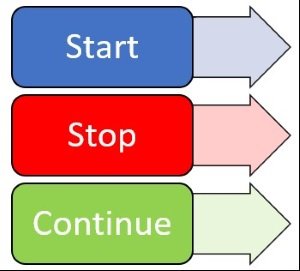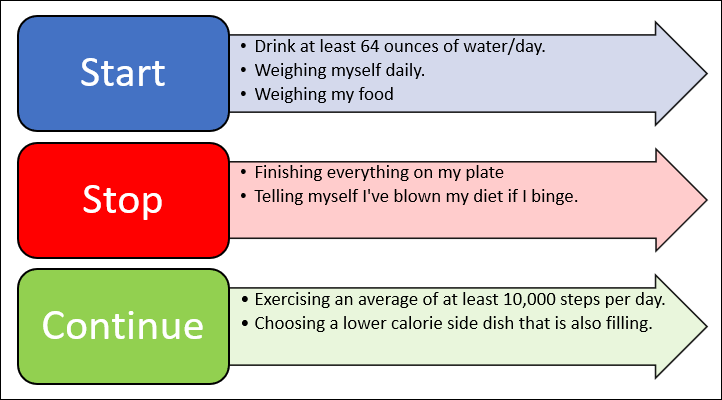Coaching leaders to create change: Using the Start, Stop, Continue Tool
The common theme across the people I’ve coached over the last two decades is the desire to improve results for their team, their organization, and themselves. One flexible tool that creates engagement, buy-in, and actionable ideas is called Start, Stop, Continue.
This process can be used effectively by:
New managers who want to engage their team and identify opportunities for increased success.
Organizations that have been through a significant change or event. (e.g., merger, acquisition, reorganization, downsizing, COVID, etc.)
Teams who are focusing on continuous improvement.
CEOs and other leaders who want to increase their personal performance.
Experienced managers who want to increase team input or expand their perspective
Businesses that are struggling to solve an issue (e.g., cashflow, sales, turnover, community support, etc.).
Process Overview
As the name suggests, participants identify how to improve results for relevant stakeholders (customers, employees, shareholders, community members) by looking at the organization from three different perspectives.
Start—During this segment, participants brainstorm activities or processes that would improve results for stakeholders.
Stop—During this segment, people identify current activities that don’t add much value or are creating barriers. Eliminating these activities enables people to spend time on high value tasks/areas.
Continue—The final category addresses the current activities that add significant value and should be continued. Periodically, people recommend that activities be continued but with modifications.
Typically, facilitation would flow through the three segments in the order outlined. However, the facilitator can and should adapt the process flow to fit the situation. For example, if this process is being used as a way to provide feedback to an individual, there may be useful to begin facilitation with Continue vs. Start.
Keys to Facilitation
Pre-work
The facilitator should develop questions for each segment that will elicit input and expand discussion. Identifying these questions in advance makes facilitation easier, extends participants’ perspectives, and improves the quality of the input.
Determine if the group will create action items during the session or if that will be done by the leader or a small group following the session.
It’s useful to provide an overview of the session to participants so they come ready to participate and share ideas.
During the session
Label three areas in the room with each of the segment titles: Start, Stop, and Continue. While there is value to doing this activity in the same room, it can be done virtually using the breakout room feature in Zoom or Teams.
Provide context on the purpose of the session—taking a short break from the everyday activities to ask, “How could we be even more effective?” The context you provide will differ based on your situation and should include an overview of the benefits of the session.
Break the group into teams of no more than five. If the groups are larger than five, you miss input from people who time to process or are introverts. The teams should include a mix of people from different work groups or areas.
Capture notes on the group white board/flip charts during the meeting. This allows you to see where there is commonality of ideas across the teams.
End the meeting with an overview of next steps. This is particularly important if you plan to finalize action items after the meeting; people will want to know how and when their input will be used.
Follow-up
Create and/or implement a plan shortly after the meeting (i.e., in less than a week). Be sure to include ideas that can produce quick wins. If you decide not to implement all the ideas immediately, provide an update on when the ones in the “parking lot” will be implemented or reviewed again.
Communicate the plan and results.
Celebrate successes!
Repeat the Start, Stop, and Continue process again to identify additional opportunities for continuous improvement.
Examples
As mentioned earlier, this process is adaptable and has been effective in diverse settings. It can be used within a team to build effectiveness or to address broader organizational issues. Let’s look at a few examples.
Situation A: New CEO facing negative business trends
One new CEO used Start, Stop, Continue shortly after moving into a challenging situation. The company was blessed with low employee turnover, but this limited their exposure to changing business trends and reduced the rate of innovation. He wanted an approach that would engage employees in solving the issues while maintain low employee turnover. During coaching, we discussed different options, and developed a plan to use Start, Stop, Continue.
These are some of the questions we developed for use during facilitation
Start
Imagine having access to an additional employee. What project would you have them do?
What new product should we offer or markets should we serve?
What back office updates would add value?
Stop
What activity/task do you tend to consistently delay doing?
What activity could be eliminated from your workday/workweek?
Continue
Which of our processes/activities add most value to our customers?
During the process, they decided to continue activities that supported exceptional customer service because that differentiated them from their competitors. They also identified the value of gathering specific data that would allow them to establish pricing that generated improved margins.
Situation B: Sales VP following a merger
Following a merger of competing organizations with very different cultures and compensation packages, a Sales VP used Start, Stop, Continue as part of her process to create a cohesive team. She used questions including:
Start
What processes could be added or changed to make this team more effective?
What communications should be added?
Stop
What task or process gets in your way of partnering?
What task or process impedes your ability to get sales?
Continue
What are we currently doing that makes it easy for you to close business and serve our customers?
What do we do that makes it easy to collaborate/be an effective team?
The discussion allowed team members to build rapport, expanded their perspectives about the value of the different approaches used prior to the merger, and identify opportunities to improve communication and collaboration. Nine months later, this sales team led the company in revenue per salesperson and the team had the highest engagement score.
Situation C: Individual who wants/needs to lose weight
While Life Coaching isn’t my niche, I worked with a client mention that their joints ached and they didn’t like what they saw when they looked in the mirror. That client decided to use the process to lose 25 pounds. (I share this so you can see the diversity in how this can be used.)
Start
o What should I start doing to feel more full/less hungry?
o What new activities should I add daily?
Stop
o What should I stop doing?
o What gets in my way of eating the appropriate number of calories?
o What has caused me to binge eat?
Continue
o What activities should I continue to support weight loss?
My client implemented the following and reached their goal.
Summary
As you can see, this tool is quite adaptable and generates results. If you are an individual or leader who wants to improve operations, engage others, expand communications, or improve teamwork, consider facilitating a Start, Stop, Continue exercise with relevant stakeholders.
However, it is important to share two additional notes. First, strong facilitation and planning skills are important. Second, be aware that the conversation is inwardly focused and doesn’t include a discussion or review of external issues that might impact results (e.g., current trends, market changes, technology shifts, etc.) As a result, it can be less effective if a significant part of your group are Late Majority or Laggards on the Innovation Adoption Curve. Late Majority and Laggards are uncomfortable with new ideas, want to fit in, and dislike risk. For that reason, they are less focused on exploring new ideas and trends.
If you need support or would like to explore coaching to resolve other leadership issues, schedule a Discovery Call with Competitive Edge HR, Inc.


